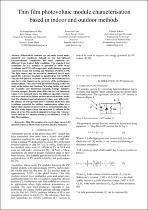 ResearchSpace
ResearchSpace
Thin film photovoltaic module characterisation based in indoor and outdoor methods
JavaScript is disabled for your browser. Some features of this site may not work without it.
- ResearchSpace
- →
- Research Publications/Outputs
- →
- Conference Publications
- →
- View Item
| dc.contributor.author |
May, Siyasanga I

|
|
| dc.contributor.author |
Pratt, Lawrence E

|
|
| dc.contributor.author |
Bokoro, P

|
|
| dc.date.accessioned | 2020-12-03T10:51:58Z | |
| dc.date.available | 2020-12-03T10:51:58Z | |
| dc.date.issued | 2020-01 | |
| dc.identifier.citation | May, S.I., Pratt, L.E. & Bokoro, P. 2020. Thin film photovoltaic module characterisation based in indoor and outdoor methods. In: SAUPEC 2020, University of Cape Town, South Africa, 29 -31 January 2020 | en_US |
| dc.identifier.isbn | 978-1-7281-4162-6 | |
| dc.identifier.isbn | 978-1-7281-4163-3 | |
| dc.identifier.uri | https://ieeexplore.ieee.org/document/9041024/authors#authors | |
| dc.identifier.uri | 10.1109/SAUPEC/RobMech/PRASA48453.2020.9041024 | |
| dc.identifier.uri | http://hdl.handle.net/10204/11683 | |
| dc.description | Copyright: 2020 IEEE. This is a pre-print version. The definitive version of the work is published in SAUPEC 2020, University of Cape Town, South Africa, 29 -31 January 2020 | en_US |
| dc.description.abstract | Photovoltaic modules are normally tested under standard test conditions defined by the International Electrotechnical Commission, but these conditions are different from typical field condition. The standard test conditions for PV modules is specified as 1000 W/m2 irradiance and 25°C cell temperature and reference spectral American Society for Testing and Materials (ASTM) G173. The light source may be natural or simulated, but it must match the reference standard as described in IEC 60904-3. The effect of spectral variations on the I-V measurements can may have a big impact on the accuracy of the performance measurements. This effect was quantified during in this the study at the Indoor and Outdoor PV testing facility in Council for Scientific and Industrial research, Energy Initiative Pretoria cments of modules under test. The obtained spectral mismatch values were affected by the absence of true spectral data of modules under test. The irradiance corrected Isc outdoor measurement values were higher than measured uncorrected Isc measurements due to the first order impact from the measured irradiance in the plane of array. The spectral mismatch between the reference devicampus. Results show different spectral mismatch values were obtained when two different spectral reference cells were used on the indoor measuree and the PV module results in an additional error for thin film modules. | en_US |
| dc.language.iso | en | en_US |
| dc.publisher | IEEE | en_US |
| dc.relation.ispartofseries | Workflow;23098 | |
| dc.subject | Thin film modules | en_US |
| dc.subject | Current-Voltage curve (I-V) | en_US |
| dc.subject | Spectral response | en_US |
| dc.subject | Short circuit current | en_US |
| dc.subject | Spectral mismatch | en_US |
| dc.title | Thin film photovoltaic module characterisation based in indoor and outdoor methods | en_US |
| dc.type | Conference Presentation | en_US |
| dc.identifier.apacitation | May, S. I., Pratt, L. E., & Bokoro, P. (2020). Thin film photovoltaic module characterisation based in indoor and outdoor methods. IEEE. http://hdl.handle.net/10204/11683 | en_ZA |
| dc.identifier.chicagocitation | May, Siyasanga I, Lawrence E Pratt, and P Bokoro. "Thin film photovoltaic module characterisation based in indoor and outdoor methods." (2020): http://hdl.handle.net/10204/11683 | en_ZA |
| dc.identifier.vancouvercitation | May SI, Pratt LE, Bokoro P, Thin film photovoltaic module characterisation based in indoor and outdoor methods; IEEE; 2020. http://hdl.handle.net/10204/11683 . | en_ZA |
| dc.identifier.ris | TY - Conference Presentation AU - May, Siyasanga I AU - Pratt, Lawrence E AU - Bokoro, P AB - Photovoltaic modules are normally tested under standard test conditions defined by the International Electrotechnical Commission, but these conditions are different from typical field condition. The standard test conditions for PV modules is specified as 1000 W/m2 irradiance and 25°C cell temperature and reference spectral American Society for Testing and Materials (ASTM) G173. The light source may be natural or simulated, but it must match the reference standard as described in IEC 60904-3. The effect of spectral variations on the I-V measurements can may have a big impact on the accuracy of the performance measurements. This effect was quantified during in this the study at the Indoor and Outdoor PV testing facility in Council for Scientific and Industrial research, Energy Initiative Pretoria cments of modules under test. The obtained spectral mismatch values were affected by the absence of true spectral data of modules under test. The irradiance corrected Isc outdoor measurement values were higher than measured uncorrected Isc measurements due to the first order impact from the measured irradiance in the plane of array. The spectral mismatch between the reference devicampus. Results show different spectral mismatch values were obtained when two different spectral reference cells were used on the indoor measuree and the PV module results in an additional error for thin film modules. DA - 2020-01 DB - ResearchSpace DP - CSIR KW - Thin film modules KW - Current-Voltage curve (I-V) KW - Spectral response KW - Short circuit current KW - Spectral mismatch LK - https://researchspace.csir.co.za PY - 2020 SM - 978-1-7281-4162-6 SM - 978-1-7281-4163-3 T1 - Thin film photovoltaic module characterisation based in indoor and outdoor methods TI - Thin film photovoltaic module characterisation based in indoor and outdoor methods UR - http://hdl.handle.net/10204/11683 ER - | en_ZA |





